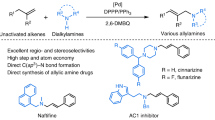Summary.
The oxidative amination of styrene with secondary amines in the presence of cationic rhodium catalysts yields regiospecifically the corresponding anti-Markovnikov enamines. Styrene as the hydrogen acceptor gave concomitantly ethylbenzene. In the presence of 1,5-cyclooctadiene (cod) preferential reduction to cyclooctene takes place. The addition of cod reduces the rate of the reaction, but also the amount of ethylbenzene produced. Here, for the first time the ratio of enamine: ethylbenzene is > 1, which is favourable in case of more expensive styrene derivatives. A screening of various ligands for oxidative amination reveals that hemilabile 2-(ω-phosphino-n-alkyl)-pyridines are superior ligands for this reaction compared to simple alkyl and aryl phosphines.
Similar content being viewed by others
Author information
Authors and Affiliations
Additional information
Received May 30, 2000. Accepted July 11, 2000
Rights and permissions
About this article
Cite this article
Tillack, A., Trauthwein, H., Hartung, C. et al. Rhodium-Catalyzed Amination of Aromatic Olefins [1]. Monatshefte fuer Chemie 131, 1327–1334 (2000). https://doi.org/10.1007/s007060070012
Issue Date:
DOI: https://doi.org/10.1007/s007060070012




